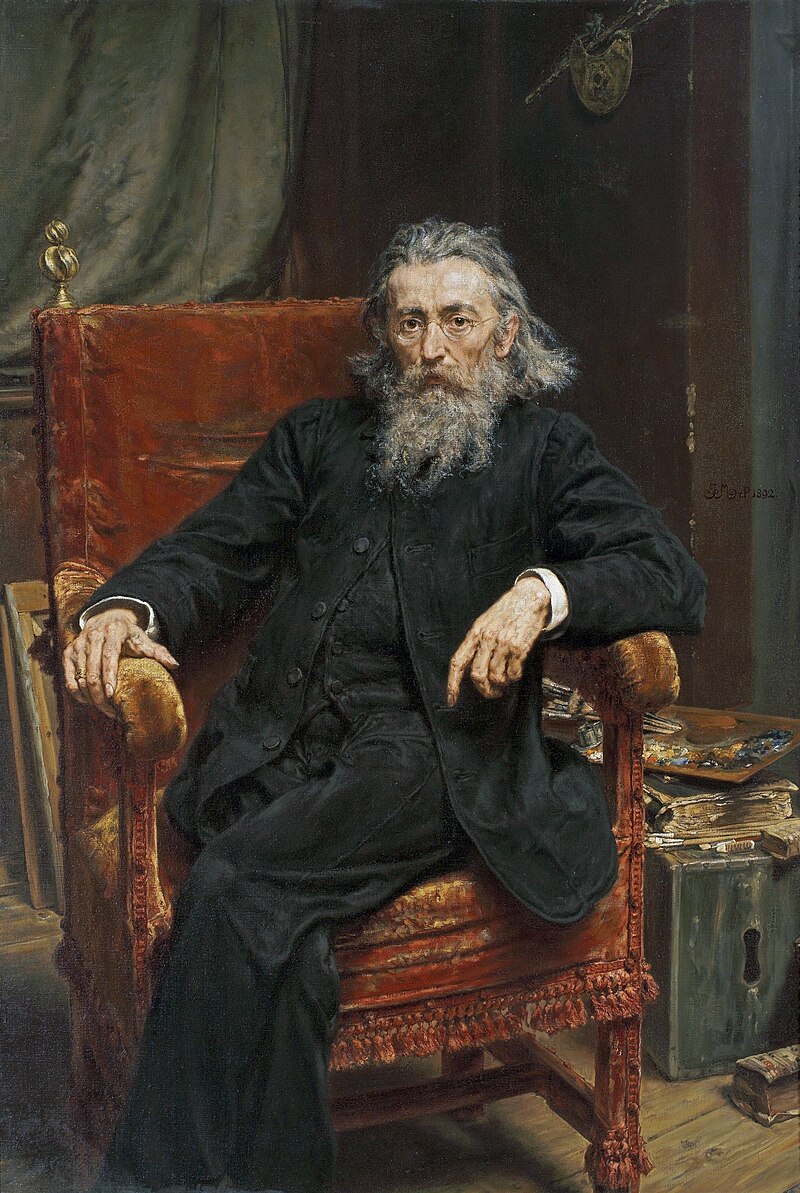Revisiting History through the brush:
A tribute to Jan Matejko
At first, Matejko's work reflects an aspiration long to be remembered if not respected and admired.
Driven by patriotism and the desire to rekindle the memories of an independent Polish past, Jan Matejko had painted various works which showcases the history of the Polish state, with its people, events, culture, and its contribution to Europe as a once independent nation.
For during his time, Poland was occupied by Russians, Germans, Austrians as part of their empires, but most of Poland was occupied by Russia, with its tsar trying to claim title as "King of Poland", once had a parliament, and an identity enough to claim Poland as autonomous within the Russian Empire similar to those of its northern counterpart, Finland. However, that same Poland was ravaged by its own occupier, who even tried to stamp out the Polish struggle especially after its failed revolt for independence. Russification was intensified, as most universities were closed only to be reopened as purely Russian-language high schools, the Polish language was banned in favour of Russian, Catholic churches were confiscated, and the country's constitution being abolished and replaced by a less liberal statue, in other words, a province like any other country in the empire that was also called "a prison of nations".
This experience somehow would say that the Poles were still trying to invoke their Polishness by any other means, saving its strength for another battle as possible. And artists like Matejko was trying to rekindle the independence spirit through means of art. After all, that period of his was the time Nationalism was at its intensification.
Prior to he as a well-known artist, Matejko was born on June 24, 1838, in the once "Free City of Kraków". His surname was originally Matejka, for his father was of Czech ancestry who moved to Poland, while his mother, a half-German, Half-Pole living in Kraków.
At a young age, Jan had witnessed events of national awakening and struggle such as the Kraków uprising of 1846 and its 1848 siege by the Austrians. These two events in which ended the existence of the Free State, yet not its struggle.
Coincidentally, his two older brothers had served under General Joseph Bem, who was also an insurgent leader fighting for the independence and unity of Poland during that period.
From his earliest days, Jan showed artistic talent, and in it he studied at the School of Fine Arts at Kraków from 1852 to 1858. There he selected historical painting as his specialisation, and in it finished his first major work, "Tsar Shuysky before Sigmund III", in 1853. However, his seminal project for his Graduation was "Sigismund I ennobles the professors of the Jagiellonian University", in 1858.
His teachers at the Kraków Academy of Fine Arts included Wojciech Korneli Stattler and Władysław Łuszczkiewicz. Years later, as he became a director at this institution, which eventually was renamed to Jan Matejko Academy of Fine Arts. A number of his students became prominent painters themselves, including Maurycy Gottlieb, Jacek Malczewski, Józef Mehoffer and Stanisław Wyspiański.
His teachers at the Kraków Academy of Fine Arts included Wojciech Korneli Stattler and Władysław Łuszczkiewicz. Years later, as he became a director at this institution, which eventually was renamed to Jan Matejko Academy of Fine Arts. A number of his students became prominent painters themselves, including Maurycy Gottlieb, Jacek Malczewski, Józef Mehoffer and Stanisław Wyspiański.
 |
| Tsar Shyusky before King Sigismund III |
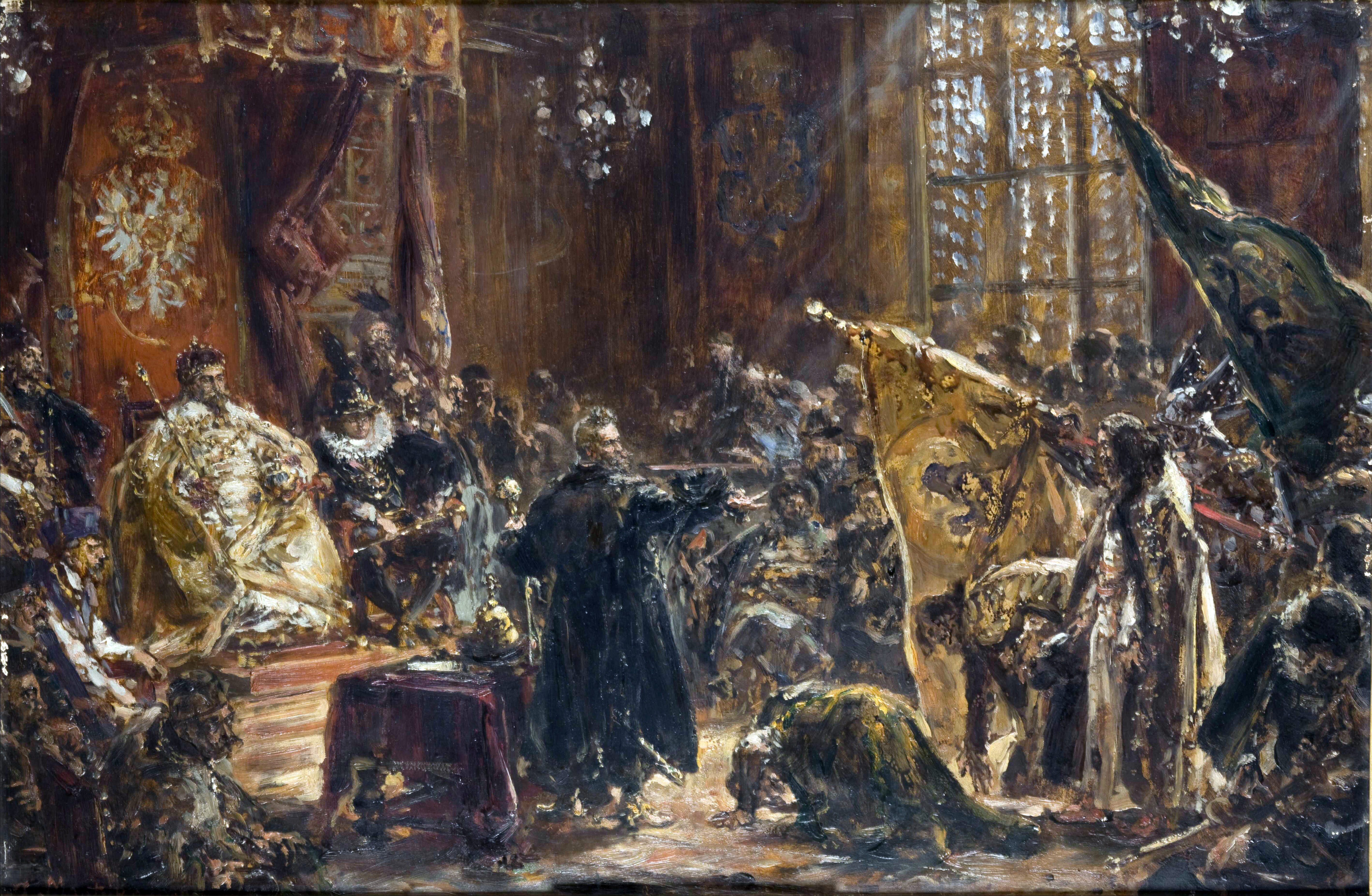 |
| Tsar Shyusky before King Sigismund III (later version) |
His commitment to nationalism and identity through art
Like any other artists dealing with history, Matejko's work reflects the aspirations of a once-"imprisoned" nation. He even took part in research as he trying to replicate how a once-independent Poland was trying to show to the world, from clothing, faith, sciences, to those of military exploits against the Teutonic Knights, Russians, and Turks.
One example of his work was in 1860, when Matejko issued an illustrated album, entitled "Clothing in Poland" (Ubiory w Polsce), a project that also reflects his intense interest in historical records of all kinds as well as his desire to promote such interest among the Polish people in an effort to intensify their patriotic feelings.
For during the January Uprising of 1863, in which he did not participate because of poor health, Matejko provided financial support, donating most of his savings to the cause, and even personally transported arms to the insurgents' camp, that somehow showed a profound expression of patriotism despite his old age as well as based from his observations during his youth.
He did also some paintings featuring scenes from the struggle, one example was the painting entitled "Polonia", which was made after the failed Uprising. There captives await transportation to Siberia. Russian officers and soldiers supervise a blacksmith placing shackles on a woman (Polonia). The blonde girl next to her represents Lithuania.
One example of his work was in 1860, when Matejko issued an illustrated album, entitled "Clothing in Poland" (Ubiory w Polsce), a project that also reflects his intense interest in historical records of all kinds as well as his desire to promote such interest among the Polish people in an effort to intensify their patriotic feelings.
| The Szlachta gentry in the album "Clothing of Poland" |
| The Polish royal family from the work "Clothing of Poland" |
However, Matejko's work was more of events related to his homeland's history. Like the earlier paintings featured in this post, it showcases how Poland expresses its once-cherished independence through events, of engaging in war like the battle of Tannenberg or of Vienna, to those of its neighbours paying homage in case of Prussia to the Polish crown.
 |
| Battle of Tannenberg |
 |
| The Prussian Homage |
| King John III Sobieski Sobieski sending Message of Victory to the Pope, after the Battle of Vienna |
Matejko's artworks did include social issues as well as Scientific wonder, that also became a part of Polish struggle. One example was the painting "Rejtan", which symbolises the Fall of Poland and the protest of Tadeusz Rejtan against the First Partition of Poland during the Partition Sejm of 1773. Rejtan, in a dramatic gesture at the Sejm, is said to have bared his chest and laid himself down in a doorway, blocking the way with his own body in a dramatic attempt to stop the other members from leaving the chamber where the debate was being held. Leaving of the chamber would have signified an end to the discussion, and the acceptance of the motion, meaning the acceptance of foreign territorial demands.
 |
| Rejtan |
Another was the "Union of Lublin", that signifies the creation of the Polish-Lithuanian Commonwealth, that effectively replaced a personal union to those of a real union between Poland and Lithuania under an elective monarchy.
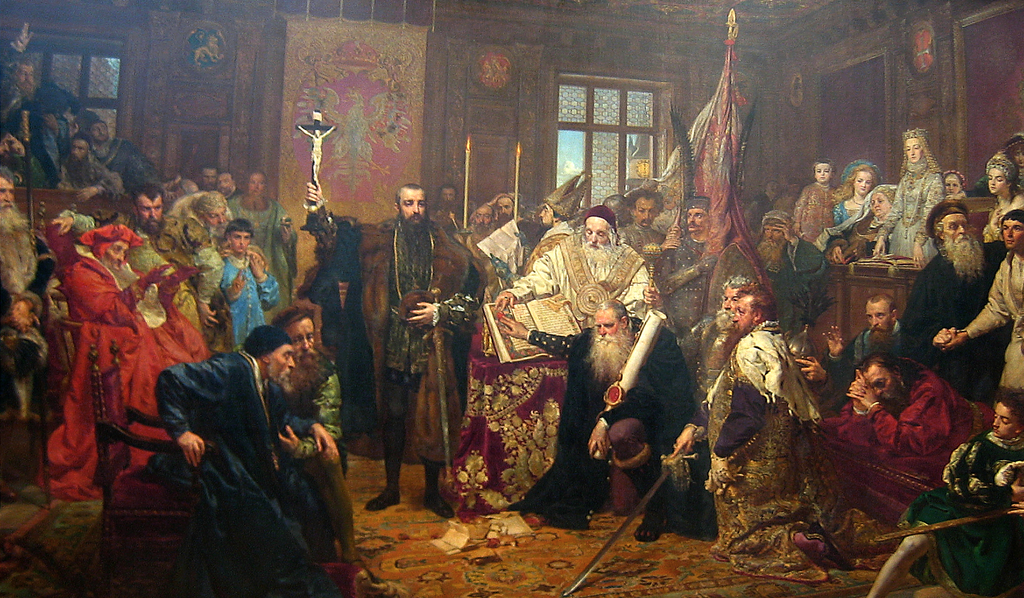 |
| Union of Lublin |
And speaking of Scientific wonder shown through art, Matejko features well-known scientists such as the alchemist Sendivogius showcasing his wonder to Sigismund Vasa, as well as the astronomer Nicholas Copernius, with his Heliocentric system. These two well-known scientists are Polish by birth, and loyal to its homeland and even offered services to the crown with the latter seeking knowledge.
| Alchemist Sendivogius to Sigismund Vasa |
 |
| Nicholas Copernicus |
However, not all paintings are focused much on Polish history, but also those from other European countries such as France. One example was of "Joan of Arc", the Maid of Orleans along with the retinue led by the young Charles VII, marching in Orleans. The setting, like other works, seemed to be romanticised.
Matejko the Freedom Fighter
His work as a patriot wasn't limited to those of Painting or any other cultural work, but also in supporting, abit indirect in the Polish liberation struggle.
For during the January Uprising of 1863, in which he did not participate because of poor health, Matejko provided financial support, donating most of his savings to the cause, and even personally transported arms to the insurgents' camp, that somehow showed a profound expression of patriotism despite his old age as well as based from his observations during his youth.
He did also some paintings featuring scenes from the struggle, one example was the painting entitled "Polonia", which was made after the failed Uprising. There captives await transportation to Siberia. Russian officers and soldiers supervise a blacksmith placing shackles on a woman (Polonia). The blonde girl next to her represents Lithuania.
| Polonia |
That artwork, like all others, expressed a desire for freedom knowing that Matejko himself has witnessed. He may not been imprisoned yet his works showed how his country has faced and trying to awaken its own patriotic feeling, knowing that his country became a mere governorate, almost stripped of its autonomy save a title "King of Poland" for a Russian Tsar.
Conclusion
Like any other artist inspired by patriotic fervor, Matejko was just doing his job to educate his fellow Pole by looking in its past in order to create a future. Critics may have described his style being "colourful, detailed and imaginative", or even pointed to his use of traditional painting style as "antiquarian realism" or "theatrical effects". if not offending in case of the "Rejetan" that made offended a number of prominent members of Polish nobility, who saw the painting as an indictment of their entire social class.
And at worst, most of his paintings were kept during World War II as the Nazis systematically tried to destroy all Polish cultural artifacts in occupied Poland. The painting "Prussian Homage", together with the "Battle of Tannenberg", was on their "most wanted" list. Fortunately, it was hidden and safeguarded throughout the war in the town of Zamość.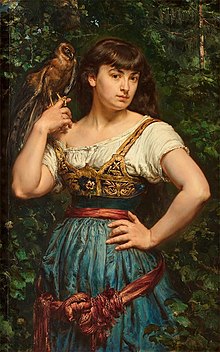 |
| Helena Matejko-Unyerzyska |
Also to mention that despite his death in 1893, his daughter, Helena, did witnessed his father's yearning to see his country independent. Like his father who once funded and supported the insurgents in 1863, she did helped victims in World War I and was awarded the Cross of Independence by president Stanisław Wojciechowski. Coincidentally, Helena was also an artist as well as his father's model in some of his paintings such as the one featured above.
And as he dedicated his life in painting Polish history and most of which had no hidden messages, Matejko's latter works, starting with the painting Stańczyk (1862), are intended to inspire the viewers with a patriotic message.
And like Matejko himself, who was influenced by Wojciech Korneli Stattler and Władysław Łuszczkiewicz, over 80 painters have been Matejko's students at some point, and many of them were influenced during his tenure as the director of the Kraków School of Fine Arts, enough to be referred to as members of "Matejko School": Prominent among them are Maurycy Gottlieb, Ephraim Moses Lilien, Jacek Malczewski, Józef Mehoffer, Antoni Piotrowski, Witold Pruszkowski, Leon Wyczółkowski, and Stanisław Wyspiański.
 |
| Stańczyk |
And as he dedicated his life in painting Polish history and most of which had no hidden messages, Matejko's latter works, starting with the painting Stańczyk (1862), are intended to inspire the viewers with a patriotic message.
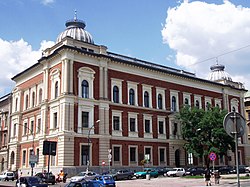 |
| Jan Matejko Academy of Fine Arts (originally known as Kraków Academy of Fine Arts, wherein Matejko used to administer and train artists) |
And like Matejko himself, who was influenced by Wojciech Korneli Stattler and Władysław Łuszczkiewicz, over 80 painters have been Matejko's students at some point, and many of them were influenced during his tenure as the director of the Kraków School of Fine Arts, enough to be referred to as members of "Matejko School": Prominent among them are Maurycy Gottlieb, Ephraim Moses Lilien, Jacek Malczewski, Józef Mehoffer, Antoni Piotrowski, Witold Pruszkowski, Leon Wyczółkowski, and Stanisław Wyspiański.
Admittingly speaking, Matejko's life's work is a work of a person who wanted not just to revisit history, but to reclaim a nation's identity and heritage. Furthermore, he's one of the painters, writers, cultural workers whom trying to invoke socio-patriotic consciousness to its own still suffering compatriots.
Like the Philippines's Juan Luna or Felix Hidalgo, they tried to counter every slander as possible through their talent, however, unlike the former two whom emphasising reforms and perhaps less toying the idea of struggle, Matejko's contribution to the independence struggle, although indirect, remains important to those whom had greatly fought and died for it.
And despite seeing recent trends in the field of arts and culture, there may be painters, artists, cultural workers who afforded to follow the same path as Matejko or any other painter whose heart clings to patriotism and to bring awareness, regardless of the style, the appearance, least the message be enough to touch one's heart, to agitate, and to sting those who slander or repress, foreign or not.
That's all for now. Sorry to use Wikipedia for the pictures and the story surrounding his life and works.

